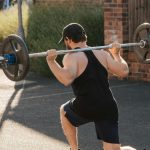Engaging in a challenging leg workout typically results in muscle fatigue and microtears, which require time to heal. This process is crucial for muscle growth and strength gains. Thus, the concept of running after a strenuous leg day might elicit hesitation from those concerned about recovery times and potential muscle strain.
On the other side of the spectrum, proponents of light to moderate running after leg day highlight the benefits such as increased blood flow, which may facilitate the clearing of lactic acid and hence possibly aid in muscle recovery. However, it is recommended that any running post-leg day should be of low intensity to avoid additional stress on recovering muscles.
Individuals should consider their own recovery rates, fitness levels, and the intensity of their leg day workouts when deciding to include running in their post-leg day routine. It is essential for runners to listen to their bodies and ensure they are fueling and hydrating adequately to support both recovery and additional exercise demands.
Understanding Leg Day
Leg day is a critical aspect of strength training focusing on the lower body muscles. It is dedicated to exercises that engage the major muscle groups in the legs, facilitating the development of muscle mass and strength.
Muscle Groups Involved
On leg day, several primary muscle groups are targeted. Squats and lunges are fundamental exercises that engage the quads (quadriceps femoris), which are the muscles on the front of the thigh, and the glutes (gluteal muscles), which form the buttocks. The hamstrings, located on the back of the thigh, and the calves (gastrocnemius and soleus muscles) are also actively worked. Together, these muscles provide stability, power, and mobility.
Compound Movements
The staple of leg day workouts are compound movements. These exercises, such as squats and deadlifts, work multiple muscle groups simultaneously and offer efficient strength building. They mimic natural movement patterns, thereby improving functional fitness.
- Squats: Target quads, hamstrings, glutes, and calves.
- Deadlifts: Engage the lower back, glutes, hamstrings, and calf muscles.
Weightlifting Impact
Weightlifting on leg day typically involves high resistance, which leads to muscle strain and microtears. This process is crucial for muscle growth, as the repair of these microtears increases muscle fiber strength and size. Regular leg-focused resistance training is essential for building lower body strength and enhancing overall muscle mass.
The Science of Recovery
Understanding the science of recovery is crucial for balancing training with adequate rest to optimize muscle repair and growth. This ensures that athletes and fitness enthusiasts can return to their activities with reduced risk of injury and improved performance.
Muscle Soreness and DOMS
Muscle soreness, often peaking 24-48 hours post-exercise, is indicative of Delayed Onset Muscle Soreness (DOMS). It is the result of microscopic tears within the muscle fibers caused by strenuous or unaccustomed exercise. These microtears stimulate the inflammation response, which is both a signal for the body to repair the damaged fibers and a common cause for the soreness experienced.
Rest and Muscle Recovery
Rest is paramount in muscle recovery. During rest days, the body focuses on repairing the microtears in muscle fibers. Protein synthesis takes place, which is essential for muscle repair and growth. The ideal rest period can range from 48 to 72 hours between high-intensity workouts to allow not just the muscles, but also the nervous system, to recover.
Active Recovery Options
Active recovery involves low-intensity exercise which promotes blood flow and aids in the reduction of lactic acid buildup. Options for active recovery include:
- Light cardio: such as walking or swimming, can gently increase circulation, helping to clear lactic acid and reduce soreness.
- Stretching: helps maintain flexibility and may reduce tightness associated with DOMS.
- Massage: can increase circulation and help to alleviate tight muscles following intense exercise.
Incorporating a thorough warm-up routine before exercise can also assist in reducing the risk of soreness by preparing the muscles for the stresses to come.
Running Post-Leg Day
Incorporating running into a post-leg day routine requires a careful balance to reap the benefits without overtaxing the muscles. Understanding the risks and management strategies is crucial for maintaining endurance and promoting recovery.
Benefits of Running
- Enhanced Blood Circulation: Light running can boost circulation, delivering oxygen and nutrients essential for muscle repair.
- Reduced Soreness: A low to moderate pace can facilitate lactate clearance, potentially lessening delayed onset muscle soreness (DOMS).
Risks of Overtraining
- Heightened Injury Risk: Overtraining can increase the likelihood of injuries as muscles are more susceptible when fatigued.
- Delayed Recovery: Ignoring the body’s need for rest can hinder the healing process, prolonging fatigue and soreness.
Managing Fatigue and Soreness
- Adjusting Intensity: Keeping intensity low, such as a gentle jog or a comfortable pace, helps manage post-leg day fatigue.
- Monitoring Physical Activity: Listening to the body and reducing the duration of runs after leg day can prevent excessive strain and promote efficient recovery.
Training Strategies and Modifications
In the wake of leg day, runners should take care to adjust their training to accommodate muscle recovery while still maintaining a balanced workout regimen.
Adjusting Your Workout Routine
After a rigorous leg day, it’s crucial to tailor subsequent training sessions to prevent muscle overexertion. Runners should aim to schedule low to moderate intensity runs or consider active recovery days involving less impactful activities such as cycling or swimming. Incorporating compound movements that work multiple muscle groups with appropriate resistance can aid in promoting muscle growth without unnecessary strain.
Importance of Stretching and Warm-up
Prior to resuming running, one should engage in a comprehensive stretching routine to alleviate muscle tension and enhance flexibility. Effective warm-up exercises, such as dynamic stretches or light aerobic activity, prepare the muscles and cardiovascular system for the demands of running, reducing the risk of injury and muscle fatigue.
Balancing Cardio and Strength
A symbiotic relationship exists between cardio and strength training. They ought not to detract from each other. To optimize this balance, integrate weights and resistance exercises into the workout routine on non-leg days. When approaching cardio post-leg day, opt for sessions that are less strenuous on the legs, such as using an elliptical or focusing on upper-body ergometer workouts. Avoid sprinting or high-intensity runs immediately after heavy weightlifting days to allow for proper muscle recovery.
Diet and Nutrition
The proper diet and nutrition are crucial in the timeframe following a challenging leg day workout, addressing the body’s heightened need for recovery and fuel replenishment.
Fueling for Performance
The body’s glycogen stores are often depleted after intense leg day exercises. It is essential for athletes to consume carbohydrates to replenish these stores, as they are the primary source of energy during aerobic and anaerobic activities. A diet rich in complex carbohydrates, such as whole grains, fruits, and vegetables, is recommended to ensure a sustained release of energy.
- Recommended Carbohydrates:
- Whole grain bread and pasta
- Brown rice
- Oats
- Fruits like bananas and apples
- Vegetables like sweet potatoes and broccoli
Post-Workout Nutritional Needs
As muscle tissues experience microtears during a workout, protein plays a pivotal role in muscle repair and growth. Consuming an adequate amount of protein post-workout aids in the recovery process. A general guideline suggests a protein intake of 25-35 grams post-exercise.
- Protein Sources:
- Chicken breast
- Greek yogurt
- Cottage cheese
- Eggs
- Plant-based options like tofu and legumes
Additional to protein, hydration and carb intake should not be overlooked. A balanced ratio of carbohydrates and protein facilitates recovery and helps diminish lactic acid buildup, enhancing muscle recovery and preparation for subsequent training sessions.
Performance Considerations
When considering running after leg day, athletes should weigh their fitness goals and evaluate how different types of training can affect their athletic performance and recovery. The selection of post-leg day activities may either support or hinder progress, depending on how they align with these goals.
Fitness Goals Prioritization
For individuals aiming to maximize muscle building in the lower body, strength training should remain the priority. This approach encourages ample recovery time, which is crucial after intense leg workouts that cause microtears in muscle fibers. Allowing 24-48 hours before introducing additional lower body stress helps to prevent overtaxing the muscles and supports muscle building.
- Priority: Muscle Building
- Activity: Strength Training
- Recovery Time: 24-48 hours
However, for those whose fitness goals are more endurance-oriented, incorporating low to moderate intensity runs after leg day can be beneficial. This form of cardio exercise promotes blood flow and can aid in muscle recovery, while also contributing to core strength and overall cardiovascular health.
- Priority: Endurance
- Activity: Low to Moderate Intensity Runs
- Contribution: Cardiovascular Health, Core Strength
Athletic Performance and Endurance
Athletic performance, particularly in endurance disciplines, can benefit from a balance between strength training and cardio workouts. It is advisable for athletes to avoid high-intensity runs after leg day, as these can hinder performance by causing additional muscle damage that delays recovery.
- Performance Aspect: Endurance
- Suggested Activity: Moderate Cardio or Rest
- Intensity: Low to Moderate
Consistent physical activity that includes both strength and endurance training is key to building a well-rounded athletic profile. By understanding and applying the right balance, one can significantly enhance their athleticism without compromising the body’s need for recovery.
- Performance Aspect: Athleticism
- Balance: Strength and Endurance Training
- Recovery: Balanced Activity to Avoid Compromise
Injury Prevention and Management
Running after a strenuous leg workout poses risks such as overuse injuries and muscle damage. To mitigate these risks, it’s crucial to recognize the early signs of injury and to follow proper rehabilitation and precautionary measures.
Recognizing Early Signs
Individuals should be vigilant for any early symptoms of injury such as increased muscle soreness, swelling, or a decrease in muscular performance, which may suggest the onset of overuse injuries. Immediate responses to these signs include:
- Rest: Necessary to prevent further damage.
- Cold Compresses: To reduce swelling and soreness.
- Elevating the Legs: To decrease inflammation.
Rehabilitation and Precautions
Proper rehabilitation measures are essential for recovery after incurring any leg-related injuries. Individuals should consider the following:
- Gradual Return to Running: Begin with low to moderate intensity to avoid additional muscle damage.
- Stretching: Incorporate stretching to enhance flexibility and aid muscle recovery.
- Adequate Hydration and Nutrition: Crucial for muscle repair and overall recovery.
Precautions to prevent future injuries include:
- Avoid Running on Hard Surfaces: To reduce impact on the muscles and joints.
- Allow for Ample Recovery Time: At least 24-48 hours post leg day before a running session.
- Monitor Training Load: Avoid dramatic increases in running intensity or duration.
Alternative Cross-Training Options
Cross-training provides runners with the flexibility to engage in other forms of exercise to aid recovery and enhance overall fitness. These alternative activities can offer the benefits of active recovery while minimizing additional strain on sore legs and muscle fibers.
Cycling and Swimming
Cycling: A form of low to moderate intensity aerobic activity, cycling helps to promote blood flow to the leg muscles without the high impact associated with running. This can contribute to a reduction in muscle soreness and aid in recovery. For runners who have recently engaged in intensive leg workouts, cycling can serve as an effective alternative to maintain endurance training while allowing muscle fibers to heal.
- Intensity: Varying from low to moderate, allowing for flexibility based on individual recovery needs.
- Frequency: Incorporate cycling sessions between running days to maintain endurance without overtaxing the muscles.
Swimming: As a low-impact, full-body exercise, swimming allows for active recovery while also enhancing cardiovascular endurance and muscle balance. The buoyancy of water alleviates pressure on sore legs, making it an excellent choice for runners seeking to engage in active recovery after a strenuous leg day.
- Intensity: Can range from light to moderate according to individual preference.
- Muscle Engagement: Utilizes lunges and provides a balanced workout that includes the upper body, core, and legs.
Incorporating Low-Impact Activities
These activities are particularly beneficial for runners experiencing muscle fibers fatigue from previous workouts. They can serve as a means of rejuvenation, propelling athletes towards improved performance without additional strain on recovering muscles.
- Yoga: This practice enhances flexibility, balance, and core strength, essential components for a runner’s toolkit.
- Pilates: Focuses on core strength, muscle control, and stability, all beneficial for achieving a more efficient running posture.
In conclusion, runners should consider integrating these low-impact, cross-training activities into their routines. They can contribute to active recovery, endurance maintenance, and overall fitness in a way that compliments and enhances running performance.
Long-Term Training and Goal Setting
Incorporating running into a long-term training plan after leg day is a strategy that aligns with fitness goals like endurance training and muscle recovery. The key to success lies in building a sustainable routine and setting realistic, incremental milestones to track progress.
Building a Sustainable Routine
Creating a sustainable routine requires understanding one’s own body and balancing different workout modalities like cardio, strength training, and recovery periods. For instance, after a heavy leg day, a runner should consider:
- Intensity and type of the run: Opt for a low to moderate intensity run to prevent further muscle damage and aid in recovery.
- Frequency of runs: Space out runs to allow muscle recovery, aiming for consistency rather than immediate performance gain.
Setting and Achieving Fitness Milestones
Achieving fitness milestones involves clear and specific goal-setting, which can revolve around several factors:
- Endurance Training: Aspiring for longer mileage or duration in running while ensuring muscle endurance keeps up with cardio goals.
- Strength Goals: Balancing running with weightlifting to manage muscle mass and strength without compromising recovery.
- Prioritization: Determining whether the focus is on muscle growth from weightlifting or weight loss and cardiovascular improvements from running, then aligning workout priorities accordingly.
Constant assessment and adaptation of one’s routine are essential to foster long-term improvement and maintain a balance between muscle endurance and overall fitness.








